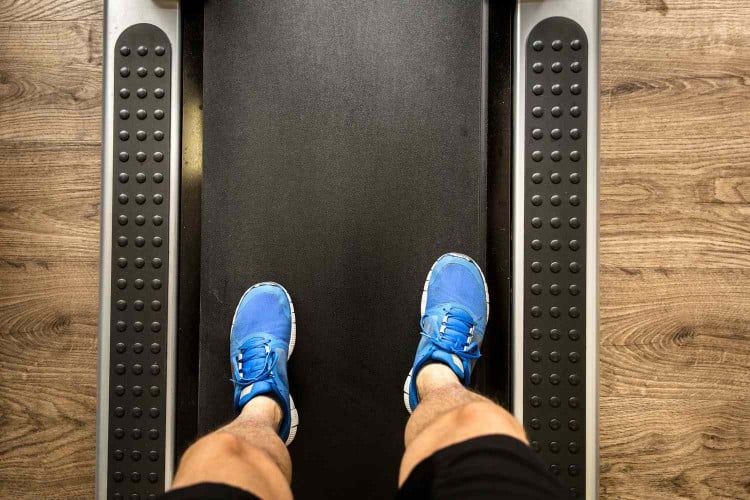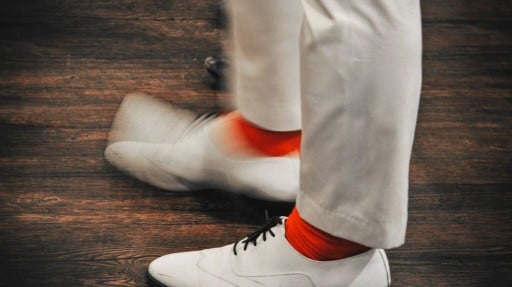- TikTok users claim that walking backwards on the treadmill can help with a variety of health issues, including relieving knee pain and improving balance and stability.
- According to experts, backwards treadmill walking does have perks, and is often used in a physical therapy or rehabilitation setting.
- To safely try walking backwards on the treadmill, start slow and make sure to use handrails and other safety measures.

FG Trade/Getty Images
A new social media trend might just be the answer to achy knees and poor posture—and all it takes is one piece of gym equipment and a little extra balance.
Walking backwards on the treadmill has become a popular trend on TikTok and Instagram. Fitness influencers and casual exercisers have credited the trend with improving balance and stability, preventing injury, and helping relieve or prevent pesky knee pain.
In one now-viral post, TikTok influencer Chayse Byrd set out to walk backwards on the treadmill for five minutes every day for one month. Eight months later, Byrd shared that backwards treadmill walking "greatly improved" the range of motion in her knees and ankles.
"I no longer feel like I have old lady knees that crick and crack with each step I take," Byrd told her 1.3 million TikTok followers.
She's not alone—a quick search for "#walkbackwards" on TikTok results in 4.1 million views, mostly from people sharing their backward treadmill walking routines touting similar benefits to Byrd, including knee-strengthening and injury prevention.
But are these claims valid—and if so, should you add backwards treadmill walking to your exercise routine? Here's what to know.
Is the '12-3-30' Treadmill Routine a Good Workout?
Does Walking Backwards Have Benefits?
Walking backwards does have some perks, Nancy R. Kirsch, DPT, PhD, vice chair of Rehabilitation and Movement Sciences at Rutgers, The State University of New Jersey, told Health.
“One of the primary benefits of backward walking is for balance training, including the ability to shift directions and maintain balance, which is essential in fall reduction,” she said.
Walking backwards throws off your center of gravity a bit, requiring you to develop more stability, Ashley Rawlins, PT, DPT, a physical therapist and clinical specialist at Origin Physical, told Health.
Physical therapists routinely use backwards walking as a rehabilitation tool, noted Kirsch, particularly for people with neurological issues stemming from a stroke, Parkinson’s disease, or another condition.
"Walking backwards also just helps counteract all the forward motion you do on a daily basis," Karen P. Hamill, DPT, a physical therapist at UCLA Health, told Health. Walking backwards allows you to use different muscles than you do for forward-facing activities, she said, which helps to build strength and prevent injury.
Reverse walking may also help with knee issues. One study from 2019 suggested that the exercise can improve muscle strength for people with patellofemoral pain syndrome (runner’s knee).
Another study from that year found that people with knee osteoarthritis had better knee strength, less pain, and overall better function after walking backward for six weeks compared to people who walked forward or received routine physiotherapy.
Runners, in particular, may benefit from walking or even lightly jogging backwards.
“People who run tend to have tight hip flexors and calves,” said Hamill. “Running backward breaks it up by lengthening the hip flexors and assists in utilizing the full range of motion of hip extension. This strengthens the gluteal muscles.”
What Is Proper Walking Form? Expert Tips on Posture, Foot Placement, and Shoe Choice
How To Safely Walk Backwards on a Treadmill
You can theoretically walk backwards anywhere, but Kirsch pointed out that the treadmill is your best bet for avoiding tripping over things and falling.
But even on a treadmill, you’ll need to take precautions.
Kirsch recommended starting at a speed of 0.5 miles per hour and increasing your pace as you feel more comfortable with the movement. If you feel like you could topple over at any minute, it’s time to scale back, added Hamill.
Hamill explained that you want to activate your core muscles to protect your back, noting that “taking large backward or sideways steps are more important than speed.”
She advised using the handrails, having someone spot you, and avoiding multitasking—watching TV or listening to music, for example—the first time you try backwards walking. If you have a medical condition that causes balance issues and you don't have anyone to spot you, it's best to only do the exercise in a rehabilitation center, added Rawlins.
Holding onto an emergency release cord can also be helpful for anyone, Hamill said.
Kirsch said once you feel comfortable walking backwards, you can add an incline for extra strength and endurance.
As for length, even a few minutes is better than nothing, said Kirsch. “It does not have to be done for a long duration during an exercise session to reap benefits."
Related pages
How Often Should You Wash Your Water Bottle?
Experts agree that it’s important to wash your reusable water bottle on a regular basis, but whether

Weight loss: Dancing can benefit people with obesity, overweight
Share on PinterestDancing can be an easy, effective way to lose weight, according to recent studies.

Ozempic weight loss plateau: What is it and how to get past it
Share on PinterestAfter using Ozempic for a while, many people may reach a plateau with their weight

Is Paxlovid Still Effective Against New COVID Variants?
Paxlovid, an antiviral therapy for COVID-19, remains effective in preventing severe illness from som

Nearly Half of Heart Attack and Stroke Survivors Don't Know What 'Bad' Cholesterol Is
New research found that a majority of heart attack and stroke survivors report having high cholester

Should You Take Copper and Zinc Supplements Together?
Mixing supplements can sometimes have adverse effects or lower the efficacy of one or both supplemen

